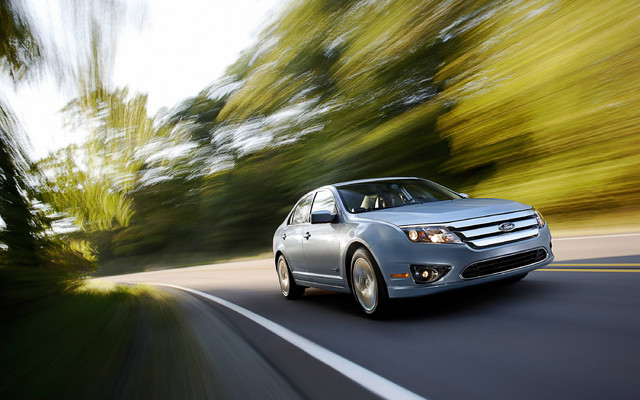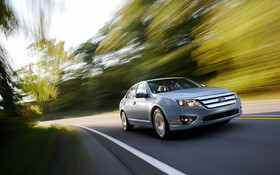The Best Family Sedan: the 2010 Ford Fusion Hybrid

| Strong points |
|
|---|---|
| Weak points |
|
I’ve been banging the Ford Fusion gong for a few years now, ever since Ford handed me the keys to an early model of the then-homely sedan at the automaker’s Dearborn facility. With a spacious interior, an excellent drivetrain, and a very attractive pricing schedule, the only drawback was the sheetmetal treatment... and those horrific rice rocket taillights. But, even with the bland steel and blingy rear end, it sold reasonably well and put a shot across the bow of the Japanese giants of Toyota and Honda.
And now they’ve blown them out of the water. Like an atom bomb giving the Bikini Atoll a quick lesson in physics, you can expect the Ford Fusion Hybrid to seriously rearrange the face of the family sedan marketplace. Why? Because this is, without hesitation or doubt, the best four door family sedan on the planet.
On the outside, a revised exterior exchanges the bland old three bar grille and hideous taillights for far more striking pieces that are downright handsome. The grille still has three bars, but now overrides sportier headlights below a powerfully domed hood. A large opening below the grille is centered between larger fog light openings, all of which conspire to give the new car a significantly more aggressive look. Interestingly, unlike many other Hybrids, Ford doesn’t alter the Hybrid’s front end in the name of aerodynamics, leaving identification to the Hybrid and Leaf badging, as well as a set of unique 17” wheels.
Inside, clues to the Hybrid’s high tech powerplant are also limited. The seats and other sundries are all standard Fusion fare, which is a blessing. With plenty of soft touch materials and equally comforting seats, the cabin is a pleasant place to pass the time. The seating position is perfect, and the controls’ layout is simple and easy to use, and will be familiar to those well acquainted with Ford’s other products. Likewise, the plethora of controls on the steering wheel mean you can operate most of the systems without ever needing to take a hand off the wheel. Both front and rear seats provide plenty of room, and I easily fit in behind my unadjusted driver’s seating position with a solid 8” of air separating my kneecaps from the seatback.
But, the second you twist the key, a huge difference becomes apparent. Flickering to life, a pair of LCD screen flanking a traditional speedometer display an image of grass behind a glowing Ford oval before fading into their standard gauge layout. Completely customizable, the driver can choose from a variety of layouts and options, with the most comprehensive including a brilliant “power” gauge. Displaying your torque demand as a moving line within a vertical bar, it displays a green bracket that represents the torque available from the electric motor alone. So, when shuffling along in traffic, you can modulate your throttle position to keep the torque demand indicator within the electric power bracket; never starting the motor. Once you break out of traffic, the battery can power the car up to 75 kilometres per hour. So while most hybrids turn the engine on to simply maintain the speed of traffic, the Fusion can keep up with traffic on the alone. But, as battery power is depleted, the green bracket shrinks, and eventually disappears when the motor is started to recharge the battery cell. When the car is turned off, both LCDs fade to black, but the right one displays a trip summary, including how far you travelled, your average fuel economy and your litres consumed.
Abide by that great torque gauge, and you will be astounded by the fuel economy. Sipping gas at a nearly Prius-like rate, my best trip averaged just 4.5 litres per hundred kilometres over that span of 40 kilometres of mixed driving. Of course, smaller trips within a few city blocks were conducted on electric power alone and rewarded with a trip summary of 0.0 l/100 km, and 0 litres consumed. In either case, a week’s worth of testing rendered a still-impressive average of 5.1 l/ 100 km.
Now, normally I’d launch into a technical diatribe about the technological advancements that make this sort of mileage possible, but the reality is, it doesn’t matter. There may as well be miniature unicorns trotting away on tiny treadmills inside the battery housing for all I care. Fact is; if you were to plant an unknowing driver in the driver’s seat, there’s a strong possibility that they’d never know it was a hybrid until they had to pull in at a pump. With seamless power delivery and surprisingly sharp handling, it operates just like any great family sedan should. The chassis feels planted throughout corners, and although you can bet the wheel and tire package was tuned for maximum efficiency, it doesn’t plow through corners like other Hybrids. In fact, although the 155-horsepower powerplant isn’t exactly a screamer, it does pull the sedan’s weight with some enthusiasm, and the quick steering ratio and good body control conspire to allow you to carry surprising speed through corners. Factor in the lack of fuel stops required, and I’d wager the Fusion Hybrid to be a pretty quick point-to-point road trip car.
And it’s the combination of all these things that make it such a fantastic automobile. No matter what you compare it to, there’s simply no getting around it’s greatness. Throwing it up against the Prius and Insight is a bit of a no brainer; sure, both the dedicated hybrid models boast slightly better fuel economy, but that’s about it. As tested, the Fusion Hybrid carried a price tag of $34,449 dollars; the result of the addition of Ford’s $2,100 SYNC system. Comparably equipped, the Prius will set you back $36,565 (which still falls slightly shy of the Fusion’s spec level) while offering less space, less pace, and less comfort. Meanwhile Honda’s Insight definitely saves some coin with its top-rung EX model carrying an MSRP of just $28,895, but does little to hide its Fit-based roots. Toss it up against its closest competitor, the Toyota Camry Hybrid, and you’ll be dishing out $1,371 more dollars for a vehicle that gets worse real-world economy, offers less interior refinement, and can’t match the Fusion’s driving dynamics. Of course, all of that will take a back seat to the looks for most buyers: take a quick look at the Camry’s aging, bulbous sheetmetal and the Fusion’s taut and stylish lines look more and more appealing by the minute.
Now, there will be those that disagree with this assessment. To be blunt, most of those naysayers probably already have Camry Hybrids parked in their driveways and have never turned a wheel aboard Ford’s Fusion Hybrid, so you should probably ignore them. But, if you still find yourself doubting the excellence of Ford’s latest Hybrid product, the solution is as near as your local Ford dealer.











